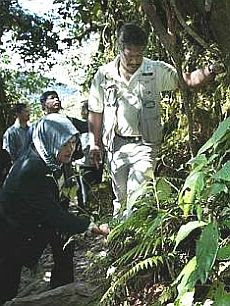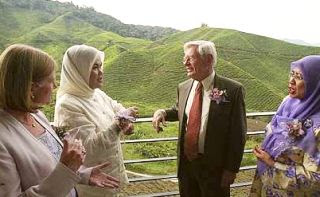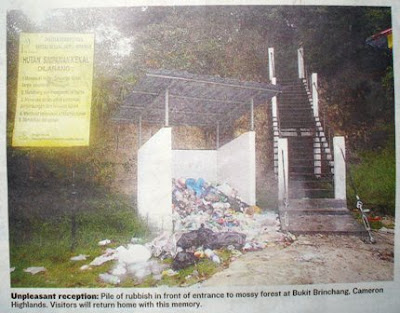Gone without a traceMonday March 26, 2007By Allan Koay
Jim Thompson’s disappearance in Cameron Highlands 40 years ago remains very much a mystery today. Moonlight Bungalow. A scenic highland retreat. War-time espionage. A mysterious disappearance. Strangely enough, all these elements in the case of the disappearance of Jim Thompson, known as the Thai silk king, could have been the perfect ingredients for a hardboiled, noir crime novel written by that other Jim Thompson, the American pulp fiction writer.
Indeed, the real-life case is as intriguing as any crime thriller, and still piques interest even today.

This year marks the 40th anniversary of Thompson’s disappearance in Cameron Highlands. The case remains as densely shrouded in mystery as it was in 1967.
Back then, the high-profile case drew frenzied media attention, leading to speculation about how and why Thompson had vanished without a trace.
Thompson, who had made a name for himself by reviving the ailing Thai silk industry, had come to Cameron Highlands from Bangkok in March that year, travelling with a companion named Constance Mangskau. Both of them met up with Singapore businessman Dr T.G. Ling and his wife, Helen, for a holiday at Moonlight Bungalow, which was then owned by the doctor.
Moonlight Bungalow is located on a hill which, today is reachable via a narrow road that branches off from the main road to the Strawberry Park Resort Hotel.
Thompson was generally known to be a warm and friendly person. But on the day that he decided to take that fateful stroll into the jungle, never to reappear, he was reportedly irritable and quite unlike his usual self.
When Thompson failed to return by dinnertime, his friends became alarmed and feared that something was amiss.
A search party of hundreds – comprising the Malaysian field police, orang asli trackers and the army – was quickly mobilised, and it fanned out across the jungle on both sides of the path that Thompson had taken. Later, American military helicopters were also sent from the US airbases in Thailand to help in the search, which went on for weeks.
When nothing had turned up by then, talk started brewing. Some people believed Thompson had fallen off a ravine, while others thought he had probably been eaten by a tiger. But these were hard to believe as Thompson was an experienced trekker and had had training in jungle warfare. He could not have simply got lost, either.
CIA connection? Yet others theorised that he had been kidnapped by rival businessmen. There was also speculation fuelled by his involvement in the US Operation Special Service (OSS) during World War II. The OSS was a precursor to the Central Intelligence Agency (CIA). Thompson had also been the intelligence chief of the OSS station in Bangkok after the war. There was talk that Thompson had left Bangkok in a hurry before heading for Cameron Highlands.
Since it was the height of the Cold War – the ideological confrontation between the democratic West and the Communists – and the United States was at war with the communists at the time, it was thought that Thompson could have been nabbed by enemy agents or even the Malayan Communist Party, as Cameron Highlands was one of the communist hotspots then. But other rumours had it that he was probably still working for the CIA, and with his cover blown and his life in danger, he had to stage his own disappearance. In fact, after the incident, there were reported sightings of Thompson in several parts of the world.
Later, two incidents added to the intrigue. Five months after his disappearance, Thompson’s sister was found murdered in her home outside Chicago. The case was classified as burglary, and the family believed it was a botched attempt to find Thompson’s last will. And exactly a year after his disappearance, Thompson’s dog in Bangkok also suffered the same fate as its owner – it vanished without a trace.
Thompson’s house in Bangkok still stands today. And some people claim that the table is still laid out for dinner every evening, as if waiting for the Thai silk king to walk through the door, suddenly.
Under these circumstances, it is easy to understand why books have been written about this case, among them Jim Thompson: The Unsolved Mystery by William Warren. A film has been made about him, too.
Journalists, documentary makers, authors and researchers are still trying to find the answers to where Thompson went. Among them is Singapore freelance researcher Edward Roy De Souza, who spent four years researching the case and published his findings in Solved!: The ‘Mysterious’ Disappearance of Jim Thompson, the Legendary Thai Silk King, in 1996.
De Souza, 52, became deeply interested in the case when it struck him that Thompson’s three friends gave conflicting answers when asked when exactly he had gone for his walk.
“As he told the press, Dr Ling remembered that they had returned to the bungalow at 2.30pm (after their trip to Gunung Brinchang), and had taken an afternoon nap,” says De Souza. “Ling mentioned that he heard footsteps outside his bedroom door at 3.30pm and he assumed they were Thompson’s. But a few days later, Helen said that she and Constance had seen Thompson leave at 1.30pm. He even waved to them and said goodbye.”
De Souza adds that the four friends had known each other for a long time, and were all into antiques.
“These are educated people,” he explains. “If all three of them came up with different times, then something was definitely wrong.”
As part of his research, De Souza visited Cameron Highlands and walked down the the jungle path that Thompson had taken before he vanished.
He said, on the day of Thompson’s disappearance, a maid at the Lutheran Mission Bungalow, about 1.5km away from Moonlight Bungalow, reportedly spotted Thompson there.
In the final analysis, De Souza believes a conspiracy had been planned long before Thompson went to Cameron Highlands. But he declines to elaborate, and will only say that he had to remove, from his book, a piece of the puzzle that was “too sensitive” too reveal.
“If I had included that piece, it would have resulted in a big hoo-ha,” he adds. “But if you read the book very carefully, you can still piece it all together and get the answer that two plus two equals four.”
An answer that is as enigmatic as the case itself. And as long as the mystery persists, the stories and speculation will never end. -- The Star. Lifestyle Focus.
Read excerpt from Edward De Souza's book: Solved! The ‘Mysterious’ Disappearance of Jim Thompson, the Legendary Thai Silk King.















